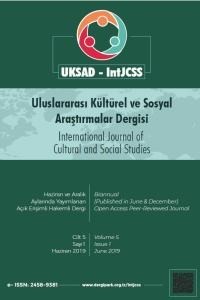Denizli İli Atletizm Hakemlerinin Hakemlikte Kalma ve Bırakma Davranışlarının İncelenmesi
Atletizm, hakem, bırakma ve devam etme davranışı, sporda adanmışlık
Examination of Stay/Leave Behavior of Track and Field Referees in Denizli
Track and field, referee, stay/leave behaviors, sport commitment,
___
- Arbucke JL (2003). Amos 5.0 update to the Amos user’s guide. Chicago, IL: SmallWaters.
- Browne MW, Gudeck R (1993). Alternative Ways of Assessing Model Fit. (Ka Bollen, Js Long, Eds.), Testing Structure Equation Models. Newbury Pdiğ, Ca: Sage, 136–162.
- Dorsch KD, Paskevich DM (2007). Stressful Experiences among Six Certification Levels of Ice Hockey Officials. Psychology of Sport And Exercise, 8, 585-593.
- Efe M, Öztürk F, Koparan Ş (2008). Bursa İlindeki Faal Futbol Hakemlerinin Problem Çözme ve Atılganlık Düzeylerinin Belirlenmesi. Spormetre Beden Eğitimi ve Spor Bilimleri Dergisi, 6, 49-58.
- Folkesson P, Nyberg C, Archer T, Norlander T (2002). Soccer Referees’ Experience of Threat and Aggression: Effects of Age, Experience, and Life Orientation on Outcome of Coping Strategy. Aggressive Behavior, 28, 317-327.
- Hu L, Bentler PM (1995). Evaluating Model Fit. (Rh Hoyle, Ed.), Structural Equation Modeling: Concepts, Issues, and Applications. London: Sage. S. 76-99.
- McIver JP, Carmines EG. (1981). Unidimensional Scaling. Quantitative Applications in Social Science, 24, 96–107.
- Pepe H, Filiz K, Pepe K, Can S. (1999). Futbol Hakemlerinin Hakemlik Geçmişleri ve Sporculuk Geçmişlerinin Tutarlı Karar Vermedeki Etkisinin İncelenmesi, Atatürk Üniversitesi BESYO, Beden Eğitimi ve Spor Bilimleri Dergisi, 1, 26-33.
- Philippe FL, Vallerand RJ, Andrianarisoa J, Brunel P (2009). Passion in Referees: Examining Their Affective and Cognitive Experiences in Sport Situations. Journal of Sport & Exercise Psychology, 31, 77-96.
- Scanlan TK, Carpenter PJ, Schmidt GW, Simons JP, Keeler B.(1993). An Introduction to the Sport Commitment Model. Journal of Sport & Exercise Psychology, 15, 1-15.
- Thatcher J (2005). Stress, Challenge, and Impression Management among Sports Officials. Sport And Exercise Psychology Review, 1, 26-35.
- Vanyperen NW (1998). Predicting Stay/Leave Behavior among Volleyball Referees. The Sport Psychologist, 12, 427-439.
- Wolfson S, Neave N (2007). Coping Under Pressure: Cognitive Strategies for Maintaining Confidence among Soccer Referees. Journal Of Sport Behavior, 30, 232-247.
- Başlangıç: 2015
- Yayıncı: Mutlu TÜRKMEN
Denizli İli Atletizm Hakemlerinin Hakemlikte Kalma ve Bırakma Davranışlarının İncelenmesi
Bülent AĞBUĞA, Fikri GÜL, Fatma AĞBUĞA, Bülent ŞENKİBAR
Yeni Medya Kavramının Ekonomi Politik Açıdan İncelenmesi
Sporcu Eğitim Merkezlerinde Yatılı Olarak Eğitim Gören Sporcuların Ahlaki Karar Alma Tutumları
Müziğin İnsan Beyni Üzerindeki Etkisi
Van Gölü’nün Rekreasyonel Turizm Potansiyelinin SWOT Analizi İle Değerlendirilmesi
Sağbetullah MERİÇ, Öznur BOZKURT
Kültür, Etnomüzikoloji ve Müzikoloji İlişkisi
Aromatik ve Tıbbi Bitkilerin Aile Çiftçilerinin Sosyo-Ekonomik Kalkınmasındaki Rolü: Safran Örneği
